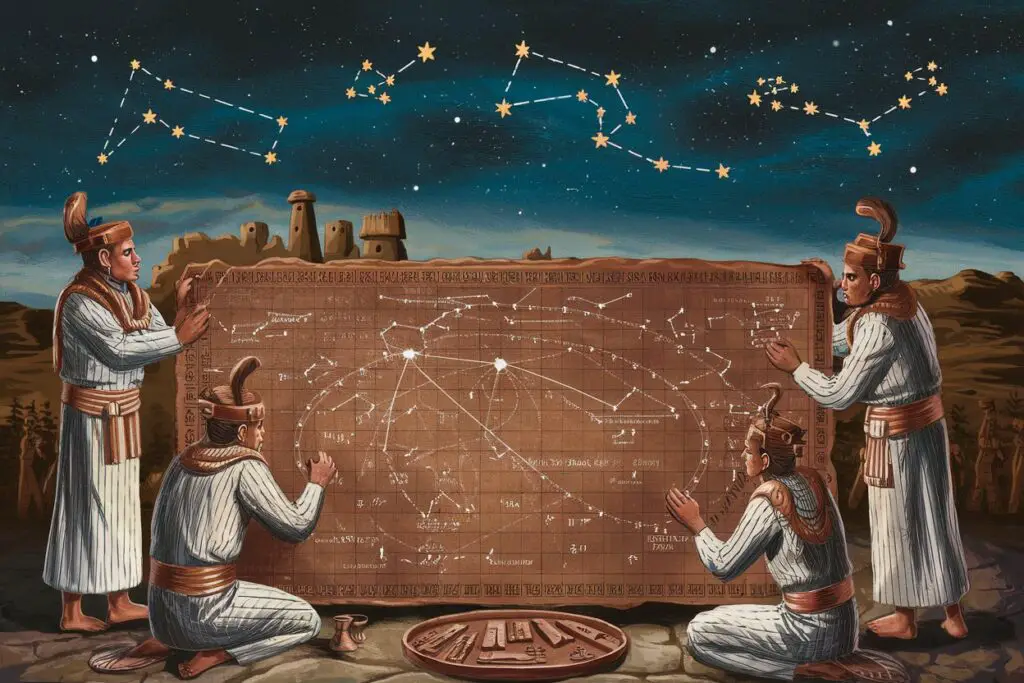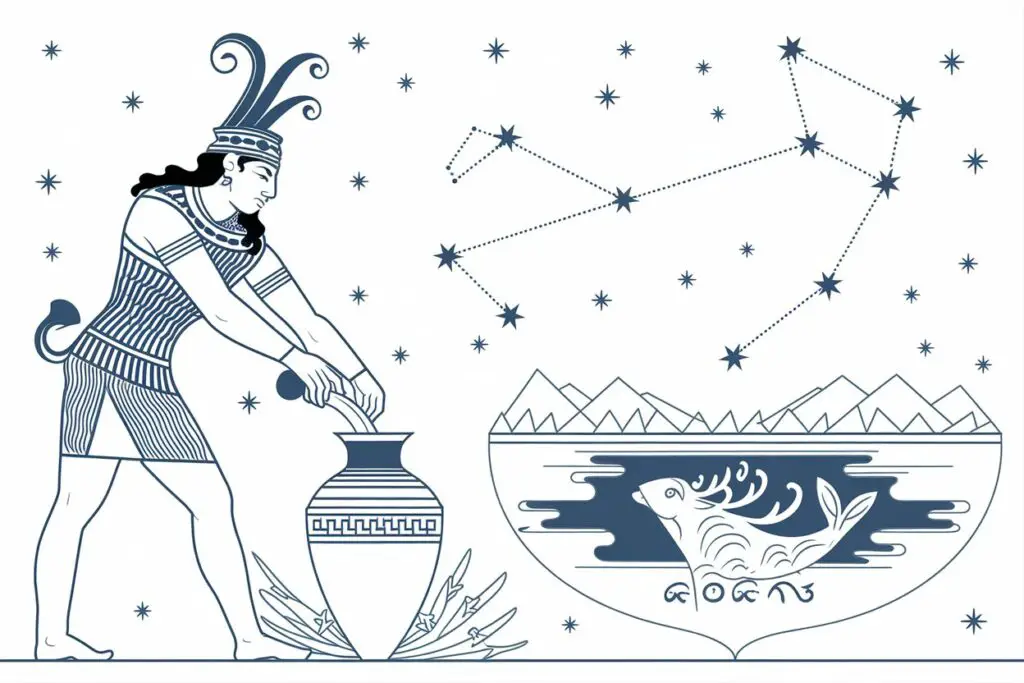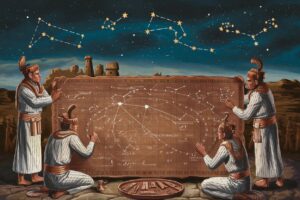The Sumerians—Pioneers of Ancient Astronomy and Astrology
The Sumerians, an advanced civilization that flourished in Mesopotamia around 3100 BCE, were among the first to systematically observe and document celestial phenomena. Their meticulous records of the night sky laid the foundation for both astronomy and astrology, influencing later civilizations such as the Babylonians, Egyptians, and Greeks. Unlike mere stargazing, Sumerian astronomy was a structured practice, deeply intertwined with their religious and societal systems.

One of the most remarkable artifacts of Sumerian astronomical knowledge is the Sumerian Planisphere, a star map discovered in the ruins of Nineveh. This clay tablet, dating back over 5,500 years, provides detailed observations of constellations and celestial movements. Perhaps most astonishingly, it records what appears to be a massive asteroid impact on June 29, 3123 BCE, with an error margin of less than one degree—a testament to the precision of Sumerian calculations.
Sumerian astronomers divided the sky into constellations, many of which later became part of the Babylonian zodiac. They identified significant celestial bodies, including the Pleiades and Orion, and tracked planetary movements over extended periods. Their observations were not purely scientific; they believed that celestial changes signaled divine messages, influencing everything from agriculture to royal decisions. This fusion of astronomy and mythology set the stage for astrology as we know it today.
Beyond their observational skills, the Sumerians developed early astronomical methods to measure time. They recorded star culminations along the north-south meridian, a technique that allowed them to predict seasonal changes crucial for agricultural planning. This practice was later refined by Babylonian astronomers, who formalized a twelve-sign zodiac, each covering 30° of the sky—a system still in use today.
The legacy of Sumerian astronomy is immense. Their star charts and celestial records influenced later Mesopotamian civilizations, who expanded upon their methods to create more sophisticated astrological systems. The Greeks, including astronomers like Hipparchus, drew upon Mesopotamian knowledge to advance their own understanding of the cosmos. Even today, modern astronomy and astrology owe much to the pioneering efforts of the Sumerians, whose careful observations provided humanity’s first structured glimpse into the workings of the universe.
How Sumerian Priests Mapped the Night Sky
The Sumerian priests were not just religious figures; they were also the first astronomers, meticulously observing the heavens to decode the messages of the gods. Their understanding of the night sky was deeply intertwined with their belief system, where celestial bodies were seen as divine inscriptions. The Sumerian word MUL meant both “star” and “inscription,” highlighting their perception of the cosmos as a form of sacred writing. Using cuneiform tablets, these priests recorded the positions of the brightest stars, the movements of planets, and the cycles of the Moon and Sun, laying the groundwork for future astronomical traditions.
One of the most remarkable aspects of Sumerian astronomy was their division of the sky into organized regions. They grouped stars into constellations, many of which later influenced the Babylonian and Greek zodiac systems. The sky was also categorized into three distinct paths—those of the gods Enlil, Anu, and Ea—each corresponding to different celestial zones. This classification allowed them to track seasonal changes, which was crucial for agricultural planning. Additionally, they identified and documented the five visible planets—Mercury, Venus, Mars, Jupiter, and Saturn—each associated with a deity, reinforcing the connection between celestial phenomena and divine will.
Beyond mere observation, Sumerian priests sought to interpret celestial events as omens. Eclipses, planetary alignments, and unusual star movements were believed to foreshadow significant earthly events, particularly concerning the fate of city-states and rulers. While their approach to astrology was not yet personal, it laid the foundation for later divinatory systems. Their star charts, inscribed on clay tablets, became invaluable records that influenced subsequent Babylonian, Greek, and Islamic astronomy. Through their meticulous mapping of the night sky, the Sumerians not only advanced human understanding of celestial mechanics but also established astronomy as an essential tool for governance and religious practice.
The Connection Between Constellations and Sumerian Mythology
The night sky was more than just a celestial canvas for the Sumerians—it was a living narrative, woven with the stories of gods, mythical creatures, and cosmic order. Ancient Mesopotamian astronomy was deeply intertwined with mythology, where constellations were not mere star patterns but divine manifestations reflecting the struggles and triumphs of the gods. Many of these celestial groupings, later adopted by the Babylonians and Greeks, trace their origins to Sumerian religious beliefs.

For instance, the constellation Aquarius was linked to Enki, the Sumerian god of water, wisdom, and creation. Enki’s domain was the abzu, the primordial freshwater abyss, and his celestial counterpart was seen pouring life-giving waters onto the Earth—an image that persisted in later Babylonian and Greek mythology. Similarly, the constellation Capricornus evolved from Enki’s sacred goat-fish, a hybrid creature symbolizing his dominion over both land and sea.
The Pleiades, known to the Sumerians as MUL.MUL, held special significance. This star cluster was associated with seven divine beings and played a crucial role in calendrical reckoning. It was also linked to the netherworld god Nergal, reinforcing its connection to both life and death. Other constellations, such as Taurus, Leo, and Scorpius, were markers of agricultural cycles, rising at key moments in the farming calendar and reinforcing the Sumerians’ dependence on celestial rhythms.
These mythological connections were not static; they evolved as Babylonian scholars refined astronomical observations while preserving Sumerian traditions. The MUL.APIN, a Babylonian star catalog, recorded many of these early constellations, ensuring their survival into later astrological systems. This fusion of mythology and empirical observation laid the groundwork for the zodiac and the broader field of astrology, demonstrating how the Sumerians transformed the night sky into a sacred map of divine order.
The Birth of the Zodiac—How Sumerians Shaped Astrological Signs
The Sumerians laid the groundwork for one of the most enduring systems of celestial interpretation—the zodiac. While the fully developed twelve-sign zodiac is credited to the Babylonians, its origins can be traced back to the meticulous star mapping of the Sumerians. As early as 3000 BCE, Sumerian priests observed the night sky with remarkable precision, identifying constellations and associating them with deities and mythological symbols. These early observations formed the foundation upon which later civilizations built their astrological frameworks.
The Sumerians categorized the sky into distinct sections, grouping stars into recognizable patterns. Many of these constellations would later be incorporated into the Babylonian and Greek zodiac systems. The Sumerians also tracked the movements of the five visible planets—Mercury, Venus, Mars, Jupiter, and Saturn—along with the Sun and Moon. Their star charts provided a rudimentary framework for understanding celestial cycles, which were closely tied to agricultural and religious calendars.
Although the Babylonians formalized the twelve-sign zodiac around the 5th century BCE, they heavily relied on Sumerian star catalogs and astral traditions. The Babylonians refined the system by dividing the sky into twelve equal parts, each corresponding to a zodiac sign covering 30 degrees of celestial longitude. This innovation allowed for more precise time measurement and astrological predictions, but its roots remained firmly embedded in Sumerian astronomical traditions.
The influence of Sumerian star mapping extended beyond Mesopotamia. The Egyptians, Greeks, and Romans all absorbed elements of Sumerian and Babylonian astrology, adapting them to their own cultural and religious contexts. By the time Hellenistic astrologers such as Ptolemy systematized Western astrology in works like Tetrabiblos, the foundational concepts had already been shaped by millennia of Mesopotamian star-gazing.
Ultimately, the Sumerians’ contributions to astrology were not just scientific but deeply mythological. Their constellations were not mere celestial markers; they were divine narratives written in the stars. This fusion of astronomy and mythology ensured that their influence would persist long after their civilization had faded, shaping the zodiac systems that continue to be studied and practiced today.
How Sumerian Star Charts Influenced Later Civilizations
The Sumerians were not only pioneers of early astronomy but also architects of a celestial legacy that shaped the astronomical traditions of later civilizations. Their meticulous star charts, inscribed on clay tablets, provided a foundational understanding of the night sky that influenced Mesopotamian, Greek, and even modern astronomical practices. These charts, which mapped constellations like Scorpius, Leo, and Gemini with remarkable precision, demonstrated an advanced knowledge of celestial movements that would be inherited and refined by subsequent cultures.
One of the most enduring contributions of Sumerian astronomy was the development of the zodiac. The Babylonians, who built upon Sumerian astronomical knowledge, formalized the zodiac into twelve equal segments, a system that would later be adopted by the Greeks and Romans. The Royal Library of Ashurbanipal in Nineveh, which housed over 30,000 clay tablets—including detailed astronomical records—served as a conduit for the transmission of Sumerian star mapping techniques to later civilizations. These texts preserved the intricate methods by which Sumerian astronomers recorded celestial phenomena, ensuring their influence extended far beyond their time.
Sumerian astronomy also played a crucial role in timekeeping and navigation. The concept of dividing the sky into measured sections was instrumental in the development of early calendars and the ability to predict celestial events. Their observations of planetary movements, which included naming planets such as Mummu (Mercury) and Lahamu (Venus), laid the groundwork for later astronomical calculations. Even as centuries passed, the precision of Sumerian celestial records remained relevant, influencing Greek astronomers like Hipparchus and Ptolemy, who refined their methods based on earlier Mesopotamian insights.
Perhaps the most striking testament to Sumerian astronomical sophistication is the discovery of a star map documenting a significant celestial event—the impact of an asteroid around 3123 BCE. This level of observational accuracy underscores the depth of their knowledge and their ability to systematically record astronomical occurrences. The influence of Sumerian star charts is not just a relic of the past; it is a testament to how early civilizations laid the foundation for modern astronomy, shaping the way humanity understands the cosmos even today.
The Role of Astrology in Sumerian Religion and Society
Astrology was not merely a tool for prediction in Sumerian civilization—it was a pillar of religious and societal structure, deeply woven into their understanding of the cosmos and divine will. The Sumerians believed that celestial bodies were physical manifestations of deities, each movement in the sky a direct message from the gods. Priests, known as baru, meticulously observed the heavens, interpreting planetary alignments and stellar patterns as divine instructions that guided temple rituals, agricultural cycles, and state affairs.
Religious ceremonies in Sumer were often timed according to astronomical events. The moon god, Nanna, and the sun god, Utu, were particularly revered, with lunar and solar cycles dictating the scheduling of festivals and offerings. This celestial calendar ensured that religious observances aligned with what the Sumerians perceived as the gods’ will, reinforcing the idea that human fate was inextricably linked to the cosmos.
Beyond religious practice, astrology played a crucial role in governance. Sumerian rulers consulted astrologers before making major decisions, such as engaging in warfare or enacting new laws. This practice continued into later Mesopotamian civilizations, with Babylonian kings like Nebuchadnezzar II relying on celestial interpretations to guide state policies. Even agricultural planning was influenced by astrology, as farmers used star charts to determine optimal planting and harvesting periods, aligning their activities with the movements of the heavens.
Astrology also reinforced the power of the priestly class. Before the establishment of monarchy, Sumerian city-states were governed by temple priests who derived their authority from their ability to interpret celestial signs. Even after kings assumed political control, priests retained significant influence, serving as intermediaries between the divine and mortal realms. This theocratic structure cemented astrology as an essential component of both religious and political life.
In essence, astrology in Sumerian society was far more than an early form of star-gazing—it was a sophisticated system that dictated religious ceremonies, influenced political decisions, and guided everyday life. The Sumerians saw the cosmos as a living, communicative force, where celestial movements were not random but carried deep significance, shaping the course of human history.
Ancient Predictions—Did Sumerians Use Astrology for Divination?
The Sumerians were not just early astronomers; they were also master diviners who believed the heavens held messages from the gods. Their civilization, flourishing around 3100 BCE in Mesopotamia, integrated astrology deeply into religious and political life. For them, the night sky was not merely a celestial map but a divine script—one that could reveal the future. Sumerian priests, known as baru, meticulously observed planetary movements, eclipses, and star alignments, interpreting these phenomena as omens for kings and rulers. This practice, known as celestial divination, was recorded on clay tablets, some of which have survived to this day.
Astrological divination in Sumerian society extended beyond the ruling elite. Farmers sought guidance from the stars for planting and harvesting, while merchants consulted celestial signs before embarking on trade expeditions. The Sumerians also practiced other forms of divination, such as interpreting dreams and casting lots, but astrology remained one of the most revered methods. Their belief in cosmic influence laid the foundation for later Babylonian astrology, which eventually evolved into the zodiac system still in use today.
By meticulously recording celestial events and their earthly consequences, the Sumerians established one of the earliest known predictive sciences. Their legacy endures, proving that humanity’s fascination with the stars and their supposed influence on fate is an ancient tradition, deeply embedded in our collective history.
What Clay Tablets Reveal About Early Astrological Practices
The Sumerians, pioneers of written records, left behind a wealth of knowledge inscribed on clay tablets, many of which provide crucial insights into early astrological practices. These tablets, primarily written in cuneiform, contain detailed astronomical observations, predictive models, and mythological connections to celestial events. Among the most significant discoveries are the Babylonian Astronomical Almanac Cuneiform Tablet and various Mesopotamian star lists, which document constellations, planetary movements, and their perceived influence on human affairs. Scholars believe these records were not merely observational but served as tools for divination, guiding rulers and priests in decision-making based on celestial omens.
One of the most remarkable aspects of these tablets is their graphical representation of constellations. Some feature circular diagrams with inscribed text, detailing the positions of stars like the Pleiades (“MUL”) and Taurus (“GUANNA”), a testament to the Sumerians’ sophisticated understanding of the night sky. Additionally, textual descriptions provide vivid imagery of celestial deities, such as the True Shepherd of Anu (Orion), depicted as a bearded figure carrying sacred items. These descriptions indicate that Sumerian astrology was deeply intertwined with mythology, where gods and cosmic forces dictated earthly events.
Beyond their religious significance, these tablets also reveal the mathematical precision of Sumerian astronomers. Some documents list degrees of separation between stars, suggesting an early attempt to measure time at night using stellar positions. The ziqpu star lists, for instance, offer numerical data that later influenced Babylonian and Hellenistic astronomical calculations. These records were not static; they were copied and refined over centuries, demonstrating a continuous scholarly tradition in Mesopotamian astronomy. Many of these tablets, now housed in institutions like the Kelsey Museum, serve as vital links between ancient and modern astrological systems.
The archaeological significance of these discoveries cannot be overstated. Excavations in Iraq have unearthed numerous cuneiform tablets, some obtained through controlled digs and others through illicit means, which complicates precise dating. However, scholars agree that these texts, dating back to the first millennium BCE, preserve an ancient intellectual tradition that shaped later astrological systems. Their influence is evident in Greek astronomy, where figures like Hipparchus and Geminus adopted Mesopotamian star cataloging methods. Ultimately, Sumerian clay tablets stand as enduring testaments to humanity’s early attempts to decipher the cosmos, blending science, religion, and mathematics into a unified system of celestial interpretation.
How Sumerian Astronomy Laid the Foundation for Modern Astrology
The Sumerians were not just skilled builders and administrators; they were also among the earliest astronomers, meticulously observing the night sky to develop a system that would later influence modern astrology. Their most enduring contribution was the sexagesimal (base-60) numerical system, which remains integral to how we measure time, angles, and celestial coordinates today (Crystalinks). This mathematical advancement allowed them to track planetary movements with remarkable precision, laying the groundwork for later civilizations to refine astrological predictions.
One of their key achievements was the identification of constellations and planetary paths, which eventually evolved into the zodiac. By tracking the movement of celestial bodies, Sumerian priests could predict seasonal changes and interpret omens, a practice that the Babylonians later expanded into a formalized system of horoscopic astrology (University of Michigan). Their predictive techniques, based on repeated celestial patterns, introduced the idea that planetary positions could influence earthly events—an essential principle in astrology that persists today.
The influence of Sumerian astronomy did not end with Mesopotamia. Their findings were passed down through the Babylonians, Akkadians, and Assyrians, eventually reaching Greek scholars such as Aristotle and Ptolemy. Ptolemy’s foundational text, Tetrabiblos, built upon Sumerian and Babylonian knowledge, codifying many astrological concepts still in use (Wikipedia). Without the Sumerians’ meticulous star mapping and mathematical innovations, modern astrology as we know it might never have taken shape.
The Lasting Legacy of Sumerian Star Mapping Today
The Sumerians were not just the world’s first great city-builders—they were also among the earliest astronomers, meticulously charting the night sky. Their star maps, recorded on clay tablets, laid the groundwork for how later civilizations understood the heavens. One such example is the K8538 tablet, which tracked a comet’s movement across eight nights, detailing its position relative to constellations like Orion and the Pleiades. This precise observational method became a model for future astronomers, influencing the Babylonian star catalogues and, eventually, Greek and Islamic astronomy.
Beyond scientific contributions, Sumerian star mapping was deeply intertwined with mythology and religion. The constellations were not just points of light; they were divine entities, each linked to gods and cosmic narratives. This sacred interpretation of the night sky carried forward into Babylonian astrology, where celestial movements were believed to predict earthly events. The idea of dividing the zodiac into twelve equal parts—a system still used today—can be traced back to Sumerian innovations.
Even in modern times, we continue using concepts first pioneered by the Sumerians. Their method of dividing the sky into recognizable patterns helped shape contemporary astronomy, and their mythological associations with the stars live on in astrological traditions worldwide. Whether through science or symbolism, the Sumerians’ celestial legacy remains written in the stars.







